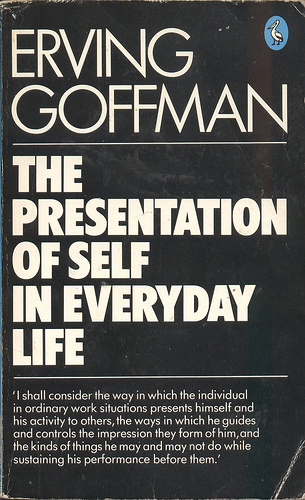 Back in the 1950s, a sociologist named Erving Goffman wrote a very influential book called The Presentation of Self in Everyday Life, about how people present themselves in the world. Goffman showed that we don’t just exist, now here now there, as static objects moving about in space, bouncing off other people. Instead, Goffman pointed out how we carefully craft the way we appear, the way we behave, and, as a result, the way we are perceived by others. Furthermore, we do so differently for different audiences, on different occasions, and with different expectations in mind. In doing so, we play different roles in social life, depending on what contexts we find ourselves in. Effectively, we become different people.
Back in the 1950s, a sociologist named Erving Goffman wrote a very influential book called The Presentation of Self in Everyday Life, about how people present themselves in the world. Goffman showed that we don’t just exist, now here now there, as static objects moving about in space, bouncing off other people. Instead, Goffman pointed out how we carefully craft the way we appear, the way we behave, and, as a result, the way we are perceived by others. Furthermore, we do so differently for different audiences, on different occasions, and with different expectations in mind. In doing so, we play different roles in social life, depending on what contexts we find ourselves in. Effectively, we become different people.
Shakespeare’s famous quote may come to mind: “All the world’s a stage/All the men and women merely players.” Erving Goffman took his inspiration too from the theatre, and the metaphors of the theatre are all through his book. Goffman’s point was that our public (and private) identities — plural, not just one identity — are complex achievements based on a whole mess of subtle actions, expectations, conventions, reactions, ways of expressing ourselves, ways of presenting ourselves. It doesn’t mean that we are inauthentic, but that our identities are constructions that we tinker with as we go. Much of this is not even fully conscious, especially where we’ve played the same role for years. It is collaborative and relational.
Back in the 1950s when Goffman wrote his book, the vast majority of human interaction was face to face. Broadcast media was still new, television was in its infancy. Most of the ‘presentation of self’ happened in real time in front of real people. Much more rarely, someone would write — and publish — a book, or an article.
A book is a very special kind of presentation of self. It is very, very carefully put together, usually with the involvement of a large team of professionals working behind the scenes with the author to make it much more careful and focused and a certain kind of ‘perfect’ than the author could have achieved on his or her own. But this was, as I say, very rare, very much the exception.
A book — given the technology of the day — also meant engaging in an industrial, mass-production enterprise. Books came in sets of hundreds or thousands, because it was only economical to produce them in quantities like that. The very idea of a book required a particular kind of a business model: an industrial, manufacturing model.
That business model relies on a particular kind of Network. In those days, the Network involved a whole lot of small bookstores that provided a book with physical, visible presence. The bookstore Network gathered readers in predicable patterns, and provided a way for a book to reach an audience, to stimulate conversation, to create a public.
Today, things are different. Today, given the Internet, most, if not all, of us have been ‘publishing’ for years already. You are already doing a lot of the things that went into publishing a book or a newspaper. You may not spend a lot of time thinking about it, but there it is, just the same.
Today, maybe half of all “presentation of self” situations are now online, mediated by the Internet. Much of it is written, or perhaps provided by images, photos, or videos. We use the technologies that used to be very special and rarified for our casual everyday interactions.
The “presentation of self” has become the “publication of self.” At the same time, publication isn’t about industrial manufacturing and economics. The Network isn’t an industrial manufacturing and distribution system; it’s something else entirely: digital, and social.
What this course wants to be about is the exploration of how we present — or publish — ourselves in that Network.